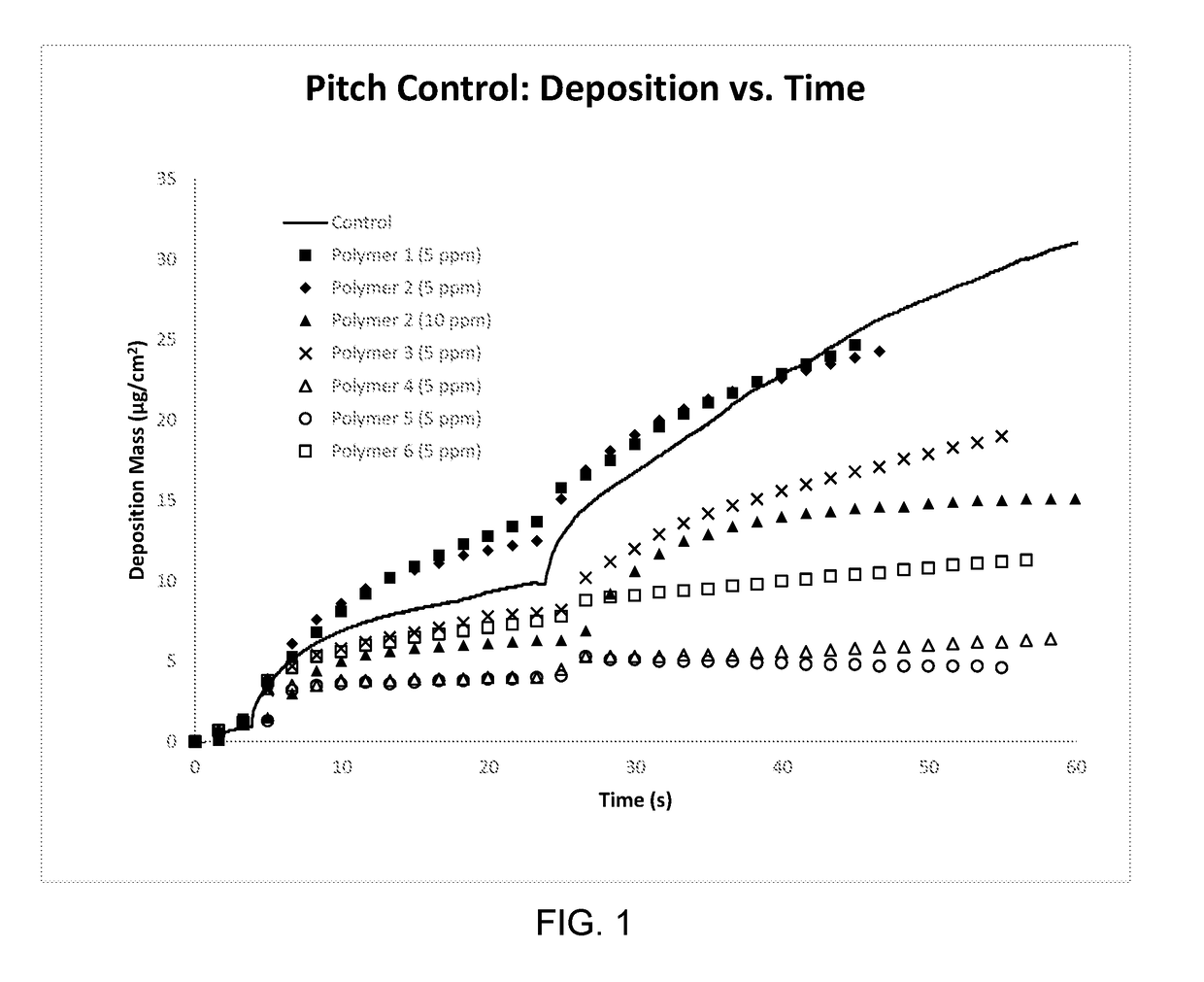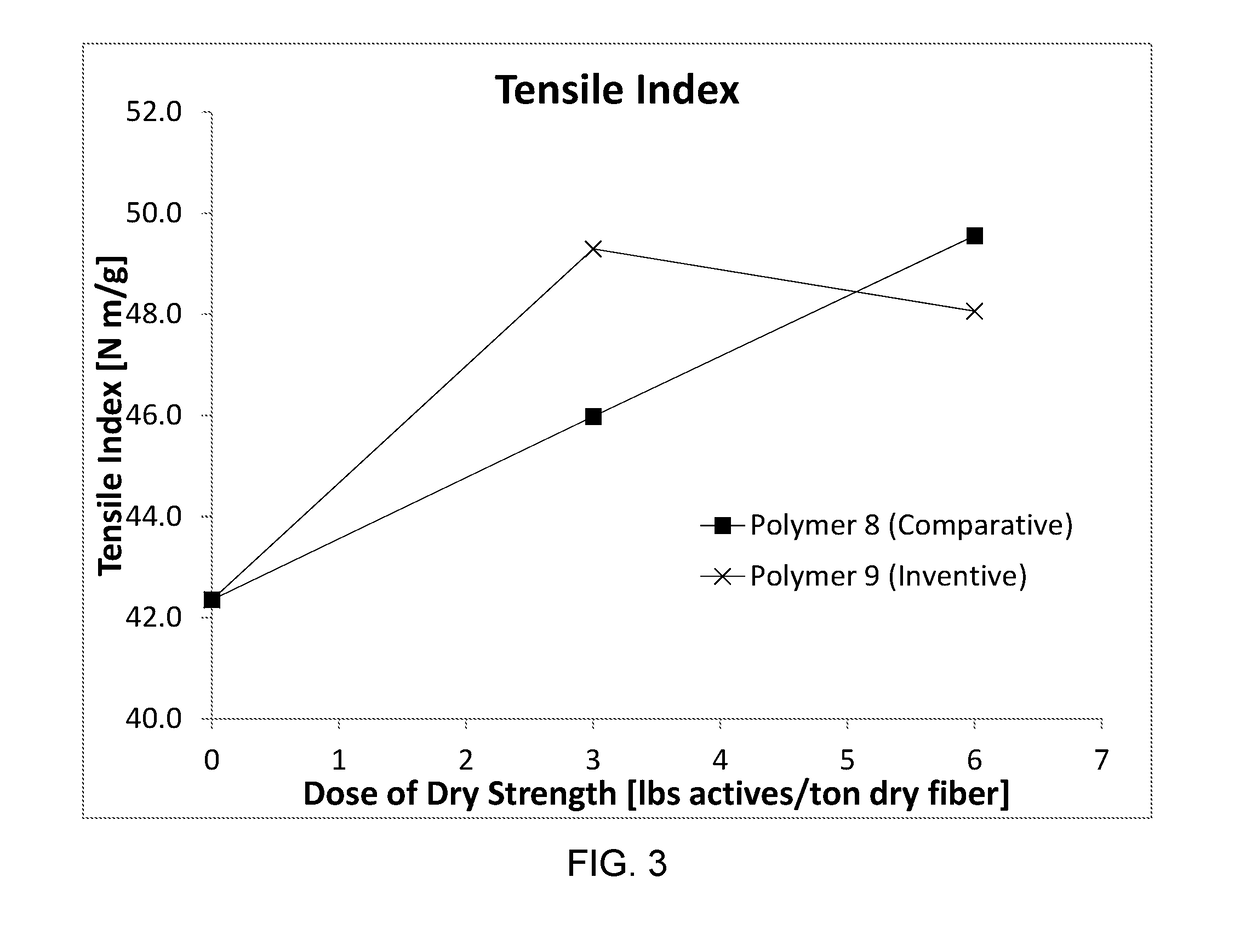Polymer for Pitch and Stickies Deposition Control in Papermaking
a technology of papermaking and polymer, which is applied in the field of polymer for pitch and stickies deposition control in papermaking, can solve the problems of poor process control, reduced process efficiency and paper quality, and downtime for cleaning, so as to improve retention and drainage, reduce pitch and stickies deposition, and enhance the dry strength properties of paper
- Summary
- Abstract
- Description
- Claims
- Application Information
AI Technical Summary
Benefits of technology
Problems solved by technology
Method used
Image
Examples
example 1
[0106]This example demonstrates the effect on pitch deposition, exhibited by a dispersive additive, as determined by the mass (lag) of pitch deposition as a function of time.
[0107]A 1000 mL 0.5 mol % softwood Kraft pulp slurry, which was pH pre-adjusted to 10.6, was placed in an SRM-3 instrument cell followed by addition of a dispersive additive (which comprised 5 ppm or 10 ppm of one of Polymers 1-7). After five minutes of agitation at 300 RPM, 100 mL of a 1 mol % solution of synthetic softwood pitch in isopropanol was added. The solution was homogenized and 8 mL of 0.5 mol % (as Ca2+ ion) calcium chloride solution was added. The pitch deposition was recorded on an SRM-3 instrument for 20 to 25 minutes, at which time the pH was adjusted to 3.5 with 5 N hydrochloric acid. Pitch deposition was monitored for another 30 to 40 minutes. The mass (μg / cm2) of pitch deposition was plotted as a function of time (FIG. 1). The “Control” data shown in FIG. 1 represents the SRM-3 data for a 1000...
example 2
[0110]This example demonstrates the effect on stickies deposition, exhibited by a dispersive additive, as determined by Nile red fluorescence reduction. The higher the fluorescence reduction percentile, the more stickies are fixed to the fibers, and thus, better stickies deposition control.
[0111]A refrigerated recycled pulp (OCC, 1.9 mol %) from a mill was gradually warmed to ambient temperature. A 150 g sample of the recycled pulp was placed in a plastic container, followed by addition of an intended fixative (comprising 95 ppm of one of Polymers 1, 3, 4, 5, and 7). The resulting slurry was agitated for 30 seconds by mechanic head agitation (800 RPM), and the agitated pulp was filtered through a 100 mesh filter. A 3 mL aliquot of the filtrate was placed in a cuvette and the fluorescence was measured as a background. To the cuvette was added 6 μL of Nile red solution, the cuvette was inverted several times to mix, and the fluorescence was measured again. The net fluorescence change ...
example 3
[0114]This example demonstrates the effect on paper dry strength, exhibited by a sheet of paper treated with a strength agent containing a diquat-based acrylamide polymer. The dry strength of the paper is assessed using the following four parameters: tensile index (FIG. 3), ring crush index (FIG. 4), STFI ratio (FIG. 5), and burst index (FIG. 6).
[0115]A 645 mL solution of paper furnish (OCC, 2.2 mol %) was treated with 0.5 lb / T flocculant and doses of 0, 3, and 6 lbs / T dry strength agent (Polymers 8 and 9). The treated fibers were then added to a handsheet mold and drained through a screen to form wet fiber pads. The handsheet was couched from the sheet mold by placing two blotters and a metal plate on the wet handsheet and roll-pressing with six passes of a 25 lb metal roller. The forming wire and top blotter were removed and the handsheet and blotter were placed on top of two new blotters. A metal plate was then placed facing the wire side of the handsheet. Five formed handsheets ...
PUM
| Property | Measurement | Unit |
|---|---|---|
| mol % | aaaaa | aaaaa |
| mol % | aaaaa | aaaaa |
| mol % | aaaaa | aaaaa |
Abstract
Description
Claims
Application Information
 Login to View More
Login to View More - R&D
- Intellectual Property
- Life Sciences
- Materials
- Tech Scout
- Unparalleled Data Quality
- Higher Quality Content
- 60% Fewer Hallucinations
Browse by: Latest US Patents, China's latest patents, Technical Efficacy Thesaurus, Application Domain, Technology Topic, Popular Technical Reports.
© 2025 PatSnap. All rights reserved.Legal|Privacy policy|Modern Slavery Act Transparency Statement|Sitemap|About US| Contact US: help@patsnap.com



